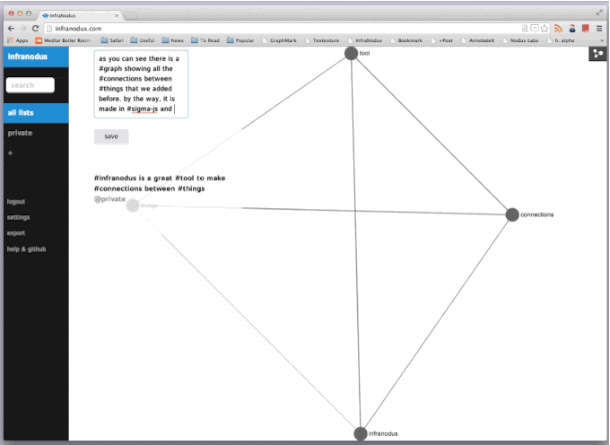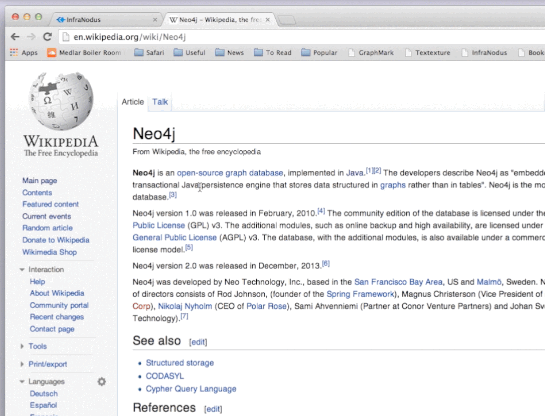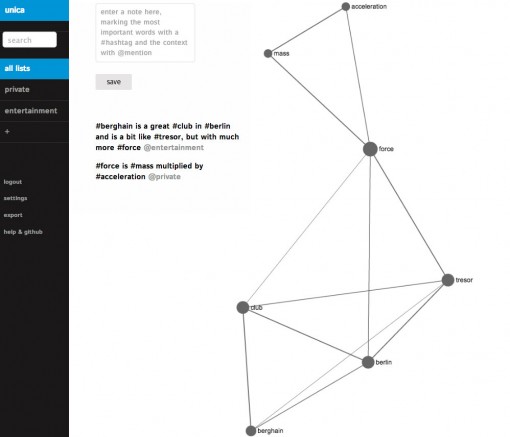Posted by Nodus Labs | March 23, 2014
InfraNodus – The Network Thinking App

When we think we create relations between things, words, and images. Things just make more sense when they connect. For example, you are much more likely to remember someone’s phone number if it has the same numbers as your postcode.
When we discover new things, it often works the same way: if you like this band, then you might also like that band; if you enjoyed reading this book, then you might also like that film. Our brain works through connections, but over time those connections fade out and it can be very hard to make sense of our knowledge with all the new data that we constantly receive.
Enter the new tool, InfraNodus – the network thinking app developed by Nodus Labs.
InfraNodus allows you to do just that: make connections between things that are important to you. Whether you want to remember a few simple facts or discover a new piece of knowledge, InfraNodus gives you a simple and fast interface to keep track of ideas, representing them as an interactive network graph.
Using the graph, you can quickly see how everything is related, what are the gaps in your knowledge, use it as a reference to remember what you have learned before, or as a tool for organizing your thoughts.
At the very core InfraNodus is designed in the way that if you start using it, you will start thinking in networks.
The big difference from online mental map software is that you can use the language to enter your data. You do not have to make complicated charts. All you need to do is to write a statement, such as “#force is #mass multiplied by #acceleration”, click enter, and you’ve got a nice graph that shows this concept. You can also create different “contexts” or lists with a @mention, for instance “#berghain is a great #club in #berlin and is a bit like #tresor, but with much more #force @entertainment” will save that last statement into a different list than the first statement, still connecting them both together.
InfraNodus is a tool that proposes a certain practice. The more you use it, the more you will think in terms of polysingularity: creating the islands of meaning, bridging connections between them, discovering the new territories, letting go of the old ones.
Other people are using it too, so when you reach the periphery of your knowledge, you will always be able to “switch” into another person’s graph, see what they already know that you don’t know yet, bridge the connection between your own networked universe and theirs.
The inspiration behind InfraNodus is the idea that the tools we use can change who we are and how we perceive the world. Really, if you are not used to the concept, thinking in networks may seem a bit strange at first. However, once you practice a bit, you will see how your mind will hungrily want to make new connections between things, invent the new pathways, remember much better what really matters, forget what is not relevant anymore.
A good way to start is to enter a few things about a domain of knowledge that you’re interested in, be it the music labels and bands that you like, which you want to keep in mind, the writers and artists you want to explore, or an outline of the field you currently study.
It’s possible to install a bookmarklet into your browser, and then you can use InfraNodus to simply bookmark the excerpts you find interesting online: from Wikipedia articles to Tumblr photos:

InfraNodus still has a long way to go, what you see in the demo above is just the first draft. However, it is free and open-source, which means you can contribute by changing the code and also run it on your own computer, without the internet. For those interested in the conceptual rationale, we invite you to read our articles on Cognitive Protocols and Cognitive Graph Data Models, which outline the main principles used when creating InfraNodus.
If you’re interested to know about how InfraNodus works, you can read our research paper on text network analysis. The basic idea is that it visualizes every word (or hashtag) as a node in the graph. When the words co-occur next to each other, they are connected. We then apply Force-Atlas algorithm to align nodes in such a way that those nodes that are more densely connected to each other are shown closer on the graph – so you can see clusters of words that are often used together this way. The nodes that are bigger are the ones that co-occur more often with other words. So you get a sort of tag cloud, but a much more advanced one, because it shows you the context.
InfraNodus is available on www.infranodus.com. Contact us to get your invitation code.


